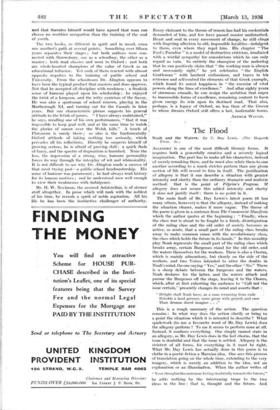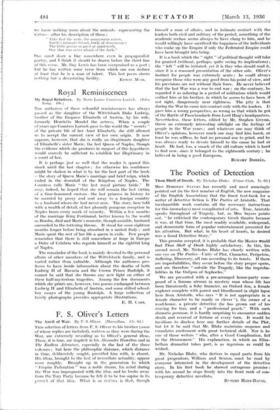The Flood
Noah and the Waters. By C. Day Lewis. (The Hogarth
Press. 5s.)
ALLEGORY is one of the most difficult literary forms. It requires both a powerfully creative and a severely logical imagination. The poet has to make all his characters, instead of merely remaking them, and he must also relate them to one another according to a much stricter pattern than any given section of life will reveal to him in, itself. , The justification of allegory is that it can describe a situation with greater intensity and clarity than the ordinary dramatic and realistic method: that is the point of Pilgrim's Progress. If allegory does not secure this added intensity and clarity it does not justify itself : there is no point in it.
The main fault of Mr. Day Lewis's latest poem (it has many others, however) is that the allegory, instead of making the situation clearer, makes it more vague. The theme of the poem is given in a sentence from The Communist Manifesto which the author quotes at the beginning : " Finally, when the class war is about to be fought to a finish, disintegration of the ruling class and the old order of society becomes so active, so acute, that a small part of the ruling class breaks away to make common- cause with the revolutionary class, the class which holds the future in its hands." In this morality play Noah represents the small part of the ruling class which breaks away, certain Burgesses stand for the old order, and the waters themselves for the workers. There is also a Chorus, which is mainly admonitory, but clearly on the side of the workers, and two Voices intended to utter the doubts in Noah's mind, the one saying " Yes," and the other " No." There is a sharp debate between the burgesses and the waters. Noah declares for the latter, and the waters attack and pursue the Burgesses off the stage, leaving it to the Chorus, which, after at first exhorting the audience to " Call not the issue certain," presently changes its mind and asserts that " Delight shall Noah have, as a man returning from exile Beholds a land greener, more great with growth and ease Than dreams dared imagine . ."- This is a rough summary. of the action. The question remains : In what way does the action clarify or bring to a point the situation which it is intended to describe ? What spadework (to use a favourite word of Mr. Day Lewis) does the allegory perform ? To me it seems to perform none at all. Instead, it confuses everything. One simply cannot state in an allegory, as Mr. Day Lewis does in the last chorus, that the issue is doubtful and that the issue is settled. Allegory is the strictest of all forms, for everything in it must be right. What Mr. Day Lewis has actually done in this poem is to clothe in a poetic fiction a Marxian idea. One sees this process of translation going on the 'whole time, extending to the very imagery, which is merely an addition to the idea, not an explanation or an illumination. - When the author writes of
"Your thoughtslike antennae feeling doubtfully towards the future,"
he adds nothing by the intervening trope to the two ideas in the line : that is, thought and the future. And we know nothing more about the animals-representing the virtues—after his description of them :
" Take first the mole, the anonymous miner, Earth's inthnate friend, lowly of demeanour : The little genius so gocd at spadework, One that was never afraid of the dark."
One must draw a line somewhere even hi propagandist poetry, and I think it should be drawn before the third line
of this verse. Mr. Day Lewis has been overpraised as a poet ; but he has written some verse from which one can deduce at least that lie is a man of talent. This last poem shows
nothing but a devastating facility. EDWIN MUIR.















































 Previous page
Previous page